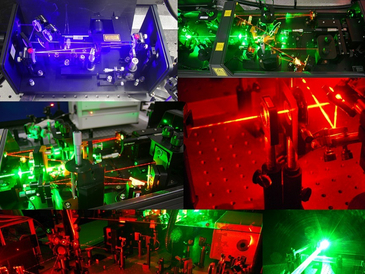A team of researchers comprising physicists from Bremen, Dortmund, Magdeburg and Wurzburg is investigating the particular type of clusters formed by photons. According to initial research findings, photons may be capable of making the transmission of data on the internet more efficient and ensuring better data security. Professor Frank Jahnke and Dr. Christopher Gies, theoretical physicists at the University of Bremen, recently published their striking results in the journal “Nature Communications”.
When photons get caught up in congestion
Anyone who has found themselves stuck in a tailback on the highway has experienced what traffic clustering can lead to. There just has to be enough traffic on the road travelling at randomly distributed speeds to increase the probability that eventually just a small number of vehicles will slow everyone else down. To keep a sufficient safety distance between automobiles driving at high speed calls for split-second response, or in physicists’ jargon: they must interact with one another. It may be that in future the same thing will apply to photons (particles that build light rays) speeding down the internet’s superhighways. Today, already a major part of data is transmitted via fiber optic cables and light pulses generated by semiconductor lasers at the cables’ connecting points. Every single light pulse comprises many thousands of photons, each one of which imports a data bit upon arrival at destination. A billion bits are transmitted per second in every gigabit network. And it takes a certain amount of energy to produce each and every photon; so alone for reasons of energy efficiency in a rapidly growing internet, there is no alternative other than to constantly reduce the number of photons contained in each signal pulse.
For quite some time now, physicists have been able to build light sources using light pulses comprising low numbers of photons, and in an extreme case only single ones. This has not only brought about significant savings in energy: Using single photons also makes it possible to transmit data without risk of hacking and manipulation. This has now given rise to a whole new interdisciplinary area of quantum information processing.
Quick and dirty guide to nanolasers and super radiances
Rather surprisingly, photons and fast drivers share an important characteristic: They do not interact among equals. Photons bear the specific mark of their production process. Physicists belonging to the team surrounding Professor Manfred Bayer in Dortmund have succeeded in visualizing the individual photons contained in light pulses in a way that resembles flows of traffic. They do this using the special nanolasers built by Professor Sven Höfling and his team at the University of Wurzburg. The very special feature of these nanolasers is that their light pulses comprise very low numbers of photons. Working in parallel, theoretical physicists working with Professor Frank Jahnke and Dr. Christopher Gies at the University of Bremen and Professor Jan Wiersig at the University of Magdeburg have showed that when programmed to produce a low light output, nanolaser photons behave like automobiles on a busy highway. They exhibit the same characteristic cluster formation: When one photon comes along there is a high probability that others will follow close behind. While increasing the light output raises the number of photons they also keep a greater distance from one another. The experiments in Dortmund led to the same conclusion. And even more remarkable is the research finding that followed. Combining the sources (atom emitter or nano-emitter) that emit the respective photons results in an extremely rare situation physicists call superradiance. In the superradiance discovered in the Wurzburg nanolasers, the photons exhibit formation of super clusters. Whereas on a real highway this would bring traffic to a complete standstill, the photons contained in light pulses continue to travel through fiber optic cables uninterrupted at the speed of light, albeit now in tight groups with distinctly characteristic correlations. And it is precisely these correlations between photons that will in future make it possible to transmit information in the internet more efficiently than via the existing method in which a whole light pulse constitutes just one single bit.
The results of this collaborative effort between researchers of the four universities in Bremen, Dortmund, Magdeburg and Wurzburg were published in the highly ranked journal “Nature Communications” on May 10, 2016
For more information on this topic, please contact:
University of Bremen
Institute of Theoretical Physics
Prof.Dr. Frank Jahnke
Phone: +49 421-218 62050
email: jahnkeprotect me ?!itp.uni-bremenprotect me ?!.de

